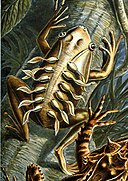Сурет:Haeckel Batrachia.jpg
Навигацияға өту
Іздеуге өту

Бұл алдын ала көрудің өлшемі: 424 × 599 пиксел. Басқа ажыратылымдықтар: 170 × 240 пиксел | 339 × 480 пиксел | 543 × 768 пиксел | 724 × 1024 пиксел | 2323 × 3284 пиксел.
Түпнұсқа файл (2323 × 3284 пиксел, файл өлшемі: 2,17 MB, MIME түрі: image/jpeg)
Файл тарихы
Файл сол кезде қалай көрінгенін көру үшін күн/уақыт дегенге басыңыз.
| Күн/Уақыт | Нобай | Өлшемдер | Қатысушы | Пікір | |
|---|---|---|---|---|---|
| қазіргі | 08:17, 2006 ж. ақпанның 24 |  | 2323 × 3284 (2,17 MB) | Ragesoss | improve version, based on same original scan |
| 05:22, 2006 ж. ақпанның 11 |  | 2318 × 3280 (2,21 MB) | Ragesoss | The 68th plate from Ernst Haeckel's 1899 ''Kunstformen der Natur'', depicting frogs classified as Batrachia. Category:Ernst Haeckel |
Файл қолданылуы
Бұл файлды мына 3 бет қолданады:
Глобалды файл қолданылуы
Бұл файл келесі басқа уикилерде қолданылады:
- arz.wikipedia.org жобасында қолданылуы
- ast.wikipedia.org жобасында қолданылуы
- az.wikipedia.org жобасында қолданылуы
- ban.wikipedia.org жобасында қолданылуы
- be.wikipedia.org жобасында қолданылуы
- bg.wikipedia.org жобасында қолданылуы
- ca.wikipedia.org жобасында қолданылуы
- ca.wikibooks.org жобасында қолданылуы
- ceb.wikipedia.org жобасында қолданылуы
- ckb.wikipedia.org жобасында қолданылуы
- dag.wikipedia.org жобасында қолданылуы
- de.wikipedia.org жобасында қолданылуы
- din.wikipedia.org жобасында қолданылуы
- el.wikipedia.org жобасында қолданылуы
- en.wikipedia.org жобасында қолданылуы
- Wikipedia:Featured pictures thumbs/04
- Wikipedia:Picture of the day/June 2006
- User:Ragesoss/Haeckel
- Wikipedia:Featured picture candidates/Haeckel Batrachia.jpg
- Wikipedia:Wikipedia Signpost/2006-03-13/Features and admins
- Wikipedia:Featured picture candidates/March-2006
- Talk:Frog/Archive 3
- User talk:Ragesoss/Archive1
- Wikipedia:Picture of the day/June 12, 2006
- Wikipedia:POTD/June 12, 2006
- Wikipedia:POTD column/June 12, 2006
- Wikipedia:POTD row/June 12, 2006
- Kunstformen der Natur
- User:Samsara/Frog/Stable
- User:RichardF/POTD
- Wikipedia:WikiProject Germany/Gallery
- User talk:RichardF
- User:Froggyyes~enwiki
- Wikipedia:Featured pictures/Animals/Amphibians
- Unclean spirit
- User:Xophist/s5
- Wikipedia:Wikipedia Signpost/2006-03-13/SPV
- Talk:Alfred Russel Wallace/Archive 1
- Portal:Amphibians/Selected picture
- User:The Transhumanist/Sandbox144
Бұл файлдың глобалды қолданылуын көбірек көру.






